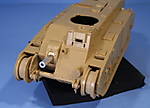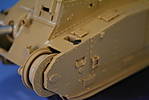1⁄35French Heavyweight Char B1 bis
21
Comments

Introduction
The Char B1 bis is one of those tanks that perhaps best exemplifies the inter-war approach to armor and tactics. Designed as an infantry support tank, it was big and lumbering and sported a combination 1-2 punch in the form of a hull mounted 75mm howitzer and a turret mounted 47mm antitank gun. It also has that distinctive wide stance and caterpillar track design developed to allow for traversing trenches reminiscent of WW1 style warfare. So ugly it’s beautiful!For this build I used the excellent kit #35282 from Tamiya along with Lionmarc replacement aluminum barrels and a set of Echelon decals for the 37 eme BCC. The Echelon set offers markings for quite a few vehicles and I selected “Marne” as my vehicle of choice and used the outstanding Char Francais site in connection with Google translation software as my main reference.
Construction
The Tamiya kit includes optional parts to produce either an early or a late production Char and different parts are called out for in the instruction sheet depending on the vehicle. By referring to the photos available of “Marne”, I was able to choose the optional parts that I needed for this specific vehicle.Steps 1-6 of the construction phase are very straightforward and deal with the assembly of various sections of the lower hull and running gear. The road wheels are a tricky arrangement, consisting of 16 pairs of wheels per side, and the skid arrangement allows for them to rotate freely within the skid. These skids then attach to the lower hull as a single arrangement, requiring some care to prevent road wheels from scattering all over the workbench in the process. In step 4 the kit barrel was replaced with the two-piece aluminum and brass fittings from the Lionmarc set. These are designed to perfectly take the place of the kit parts and no surgery or alteration was required for their use.
Step 7 calls for no less than 26 separate holes to be opened up in the top hull using a pin vise. In addition to this, the cutouts provided near the front of each sponson for the mud chute openings were removed by drilling out several holes around the perimeter and then cutting through with a sharp #11 blade and sanding down the edges.
Step 8 involves the actual installation of the mud chutes at the front hull, the rear sprocket mud scrapers, and the track skids for both the left and right sides. The mid deck hatch covers have solid molded handles which should not be present and were removed with sprue cutters and sanded down.
Step 9 joins the upper and lower hulls together and this went together smoothly with only some slight finger pressure required to get a good join all around. 6 molded on rivets on the rear engine deck were also removed per the instructions with a sharp #11 blade.
Step 10 presents the option of installing the armored visor for the driver in either the open or closed position, I chose the open and installed accordingly. The driver’s solid periscope exterior housing was drilled out with a pin vise to create the “peephole” opening. This step also directs the construction of the main headlight with the option of the hood being open or closed and I opted for the closed position. An auxiliary headlamp is also provided in the kit parts and was installed since “Marne” was equipped with this feature.
Comments
After reading (and enjoying greatly) your build article, my only regret is that I have already built mine...although it was a very quick and fun build, I'm sure it would have been much better had I been able to read your article first.
MAR 12, 2007 - 07:48 PM
Bill VERY nice build! You did this baby justice!
One question, I'm interested in how you made your rusty track wash? What did you use and what was the ratio? I reallyn like the way it came out.
Thanks
Jim
MAR 12, 2007 - 09:53 PM
Ron, Gary, Jim, thanks for the comments!
My rusty wash is simple, 90% thinner, 10% paint more or less. Here's what it looks like when it's "settled" to give you an idea of the ratio. The thinner is cloudy because it picks up some of the Metalizer over time and that just adds a bit of "character" to it I guess. :-)


MAR 13, 2007 - 07:58 AM
Nice Bill...very nice - article and build...
Let me know what you think about mine!
MAR 14, 2007 - 04:04 AM
Outstanding article and beautiful paint job! One comment if I may... The jacks on the fenders should be secured with some type of retaining tie downs. They wouldn't just sit on the fenders. Also, I have never seen 4 of them mounted on one tank. The kit came with 4 simply because Tamiya included two identical sprues in the kit. More than 2 is redundant. They were used to jack up one side of the tank at a time. Don't know of any way they could raise the whole tank off the ground without a crane. My jack comments aside, best build article I've seen in a long time. I enjoyed it.
MAR 16, 2007 - 04:50 PM
Bob,
Thanks for the comments, what you are saying makes sense in regards to the jack stands. The Tamiya instructions direct for all 4 to be installed and not knowing any better at the time, I followed along and installed them. In checking various reference photos since building this one, it's difficult to determine if there was in fact any sort of standard placement for them in relation to the fenders or the rear deck...or if they were installed externally at all depending on the different vehicles and the available reference photos.
MAR 16, 2007 - 10:04 PM
Bill,
Awsome SBS Sir....already book marked for my Char. I too have the LM set of barrels on the way. I'm either going to do a similar paint scheme, or once I get the hang of my DA airbrush, may do one of the "tree" patterns...not sure yet. Regardless, your article is killer and will be of great assistance.
Many thanks (and congrats on your new [heheheh] position!!).
Mike
MAR 16, 2007 - 10:49 PM
Thanks Mike! The different units and timeframes offer up a wide range of possibilities when it comes to the Char paint schemes. The tree patterns being one of the more intriguing to be sure! Look forward to seeing what you do with yours.
MAR 17, 2007 - 05:42 AM
Hi Bill,
I've seen photos with the jacks stowed on either the right or left fender so I don't think anybody could say one side is right and the other wrong. Most of the photos I've seen don't show them at all. I suppose it's possible they were stowed inside the vehicle although I wonder if perhaps because of their size whether many Chars didn't carry them at all and depended upon a support unit to provide the necessary lift when required. After all, how often would a crew in a combat zone be able to take the time to deploy to jacks and tilt the tank to one side? My guess is that maintenance units ultimately did the dirty work once the battle had moved on. Regards and I look forward to further examples of your work. Very well done.
MAR 17, 2007 - 07:19 AM
Copyright ©2021 by Bill Plunk. Images and/or videos also by copyright holder unless otherwise noted. The views and opinions expressed herein are solely the views and opinions of the authors and/or contributors to this Web site and do not necessarily represent the views and/or opinions of Armorama, KitMaker Network, or Silver Star Enterrpises. All rights reserved. Originally published on: 2007-03-10 00:00:00. Unique Reads: 21701



















